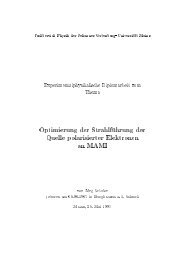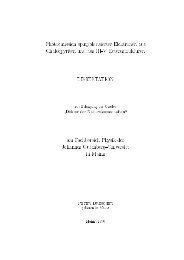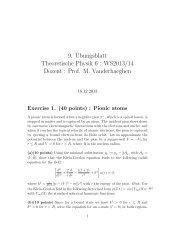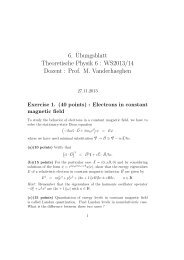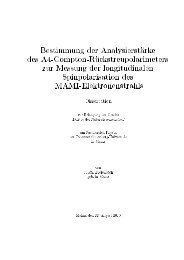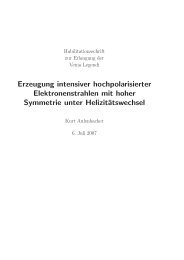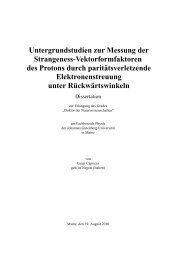Compton Scattering Sum Rules for Massive Vector Bosons
Compton Scattering Sum Rules for Massive Vector Bosons
Compton Scattering Sum Rules for Massive Vector Bosons
You also want an ePaper? Increase the reach of your titles
YUMPU automatically turns print PDFs into web optimized ePapers that Google loves.
3.2 <strong>Scattering</strong> Kinematics<br />
A generalized parametrization of the 4-momenta is<br />
p = (E, p), p ′ = (E ′ , p ′ ),<br />
q = (ω, q), q ′ = (ω ′ , q ′ ),<br />
(3.20)<br />
where E (′) and ω (′) are the initial-(final-)state target particle and photon energies in a<br />
given frame, respectively. In all frames, the energy-momentum conservation holds:<br />
p µ + q µ = p ′µ + q ′µ . (3.21)<br />
Due to the on-shell condition <strong>for</strong> external particles, the Mandelstam variables are<br />
constrained by the relation<br />
s + t + u = ∑ i<br />
m 2 i = 2M 2 (3.22)<br />
In general, the differential cross section <strong>for</strong> unpolarized 2 → 2 scattering is defined as<br />
dσ(s) =<br />
1<br />
8π 2 λ 1 2 (s, m 2 a, m 2 b ) ∫ d 3 p 1<br />
2E 1<br />
d 3 p 2<br />
2E 2<br />
δ (4) (p a + p b − p 1 − p 2 ) |M fi | 2 . (3.23)<br />
Here, |M fi | 2 is the averaged sum over all spin states of the matrix element,<br />
|M fi | 2 := 1 ∑<br />
|M fi | 2 . (3.24)<br />
4j<br />
s i ,r i<br />
The cross section contains the kinematic triangle function, which is defined as<br />
λ ( s, m 2 a, m 2 b) :=<br />
( (√m<br />
2<br />
a +<br />
√ ) (<br />
)<br />
m 2 2<br />
b<br />
s − (√ √ )<br />
)<br />
m 2 a − m 2 2<br />
b<br />
, (3.25)<br />
The relativistically covariant integral over the final state momenta is the N-body phase<br />
space integral which has the <strong>for</strong>m<br />
∫<br />
R 2 (s; m 2 1, m 2 2) := d 4 p 1 d 4 p 2 δ(p 2 1 − m 2 1)δ(p 2 2 − m 2 2)δ (4) (p a + p b − p 1 − p 2 ). (3.26)<br />
After integrating over p 2 and identifying p a ≡ p, p b ≡ q, p 1 ≡ p ′ as above, we obtain<br />
R 2 (s) =<br />
∫ d 3 p<br />
2E δ(s + p′2 − 2(p + q) · p ′ ) (3.27)<br />
29



